Neurotransmitters: What You need to Know
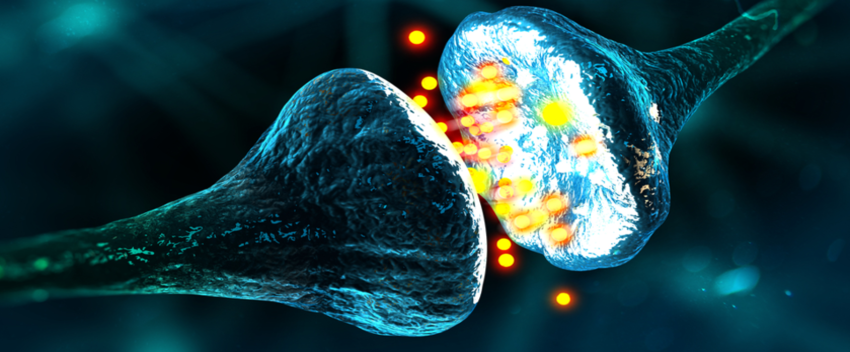
Neurotransmitters are chemicals that cross synapses to transmit impulses from a neuron to another neuron, glandular cell, or muscle cell. In other words, neurotransmitters are used to send signals from one part of the body to another. Over 100 neurotransmitters are known. Many are simply constructed from amino acids. Others are more complex molecules.
Neurotransmitters play a major role in shaping everyday life and functions.
Their exact numbers are unknown, but more than 100 chemical messengers have been uniquely identified.
For example, they regulate heartbeat, tell the lungs when to breathe, determine the set point for weight, stimulate thirst, affect mood, and control digestion.
The synaptic cleft was discovered by Spanish pathologist Santiago Ramón y Cajal in the early 20th century. In 1921, German pharmacologist Otto Loewi verified that communication between neurons was the result of released chemicals. Loewi discovered the first known neurotransmitter, acetylcholine.
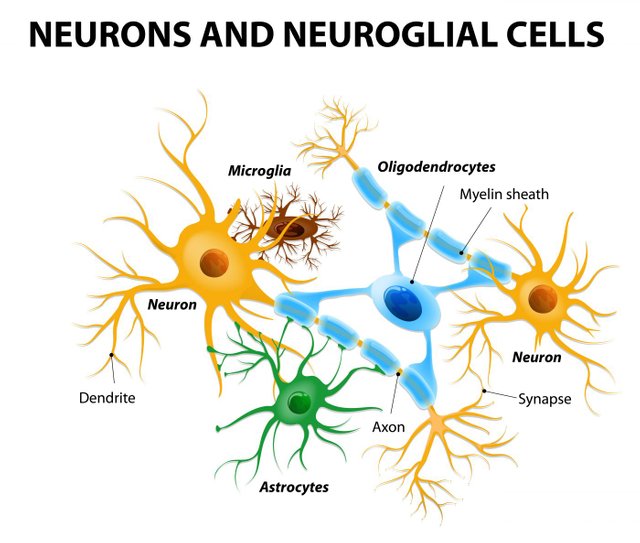
Neurons and neurological cells
How Neurotransmitters Work
The axon terminal of a synapse stores neurotransmitters in vesicles. When stimulated by an action potential, synaptic vesicles of a synapse release neurotransmitters, which cross the small distance (synaptic cleft) between an axon terminal and a dendrite via diffusion. When the neurotransmitter binds a receptor at the dendrite, the signal is communicated. The neurotransmitter remains in the synaptic cleft for a short time.
Then it is either returned to the presynaptic neuron through the process of reuptake, metabolized by enzymes, or bound to the receptor.
When a neurotransmitter binds to a postsynaptic neuron, it can either excite it or inhibit it. Neurons are often connected to other neurons, so at any given time a neuron may be subject to multiple neurotransmitters.
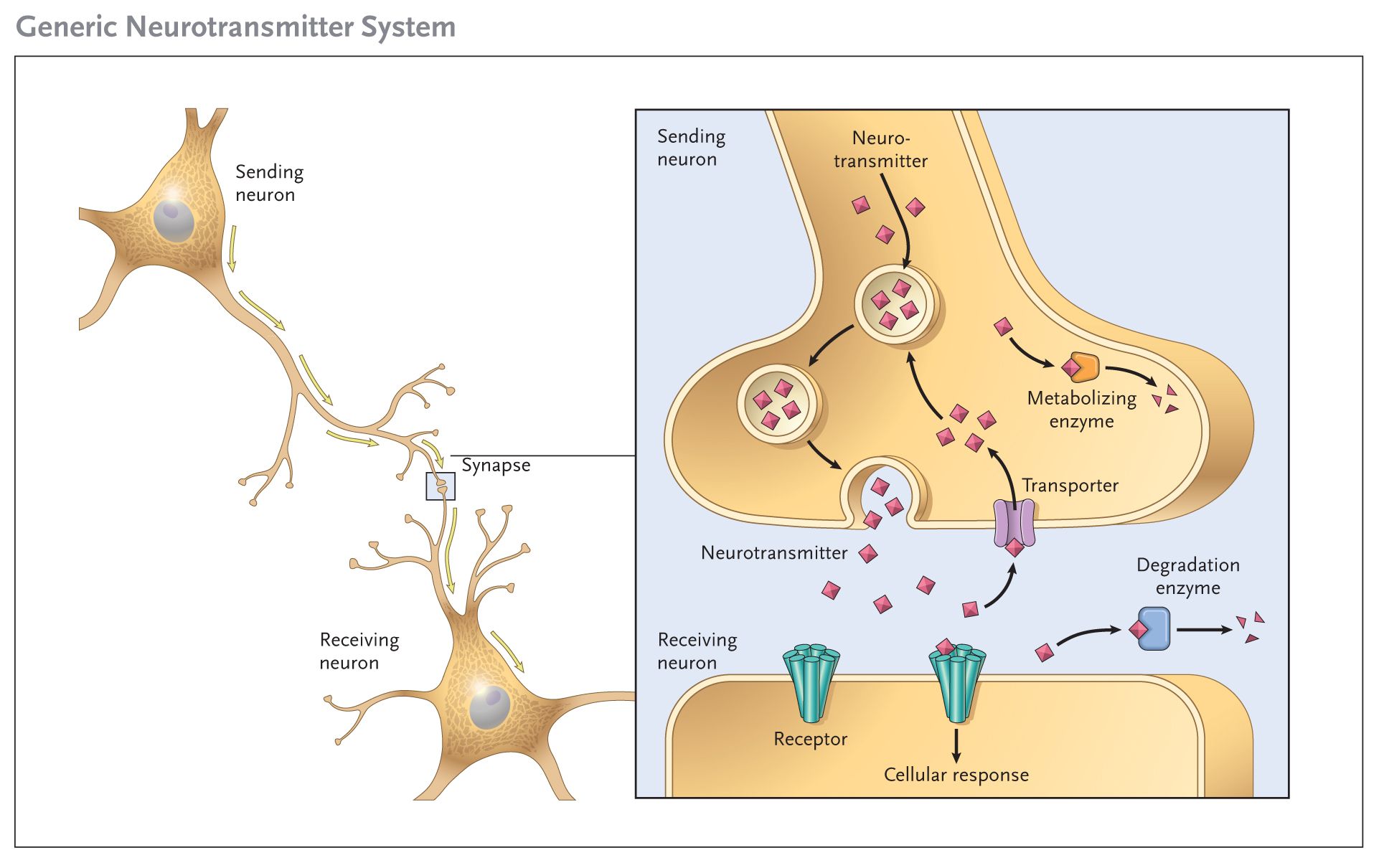
Generic Neurotransmitter System
Types Of Neurotransmitters
There are many different ways to classify neurotransmitters. Dividing them into amino acids, peptides, and monoamines is sufficient for some classification purposes.
Major Neurotransmitters
Amino acids: glutamate, aspartate, D-serine, γ-aminobutyric acid (GABA), glycine
Gasotransmitters: nitric oxide (NO), carbon monoxide (CO), hydrogen sulfide (H2S)
Monoamines: dopamine (DA), norepinephrine (noradrenaline; NE, NA), epinephrine (adrenaline), histamine, serotonin (SER, 5-HT)
Trace amines: phenethylamine, N-methylphenethylamine, tyramine, 3-iodothyronamine, octopamine, tryptamine, etc.
Peptides: somatostatin, substance P, cocaine and amphetamine regulated transcript, opioid peptides
Purines: adenosine triphosphate (ATP), adenosine
Others: acetylcholine (ACh), anandamide, etc.
In addition, over 50 neuroactive peptides have been found, and new ones are discovered regularly. Many of these are "co-released" along with a small-molecule transmitter. Nevertheless, in some cases a peptide is the primary transmitter at a synapse. β-endorphinis a relatively well-known example of a peptide neurotransmitter because it engages in highly specific interactions with opioid receptors in the central nervous system.
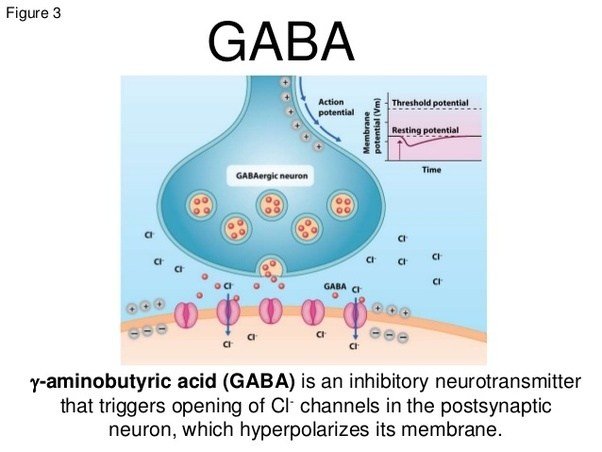
Important Neurotransmitter Actions
Glutamate is the most abundant neurotransmitter in humans, used by about half of the neurons in the human brain. It is the primary excitatory transmitter in the central nervous system. One of its functions is to help form memories. Interestingly, glutamate is toxic to neurons. Brain damage or a stroke can lead to an excess of glutamate, killing neurons.
GABA is the primary inhibitory transmitter in the vertebrate brain. It helps to control anxiety. GABA deficiency may result in seizures.
Glycine is the main inhibitory neurotransmitter in the vertebrate spinal cord.
Acetylcholine stimulates muscles, functions in the autonomic nervous system and sensory neurons, and is associated with REM sleep. Many poisons act by blocking acetylcholine receptors. Examples include botulin, curare, and hemlock. Alzheimer's disease is associated with a significant drop in acetylcholine levels.
Norepinephrine (noradrenaline) increases heart rate and blood pressure. It is part of the body's "fight or flight" system. Norepinephrine is also needed to form memories. Stress depletes stores of this neurotransmitter.
Dopamine is an inhibitory transmitter associated with the reward center of the brain. Low dopamine levels are associated with social anxiety and Parkinson's disease, while excess dopamine is related to schizophrenia.
Serotonin is an inhibitory neurotransmitter involved in mood, emotion, and perception. Low serotonin levels can lead to depression, suicidal tendencies, anger management issues, difficulty sleeping, migraines, and an increased craving for carbohydrates. The body can synthesize serotonin from the amino acid tryptophan, which is found in foods such as warm milk and turkey.
Endorphins are a class of molecules similar to opioids (e.g., morphine, heroin) in terms of structure and function. The word "endorphin" is short for "endogenous morphine." Endorphins are inhibitory transmitters associated with pleasure and pain relief. In other animals, these chemicals slow metabolism and permit hibernation.
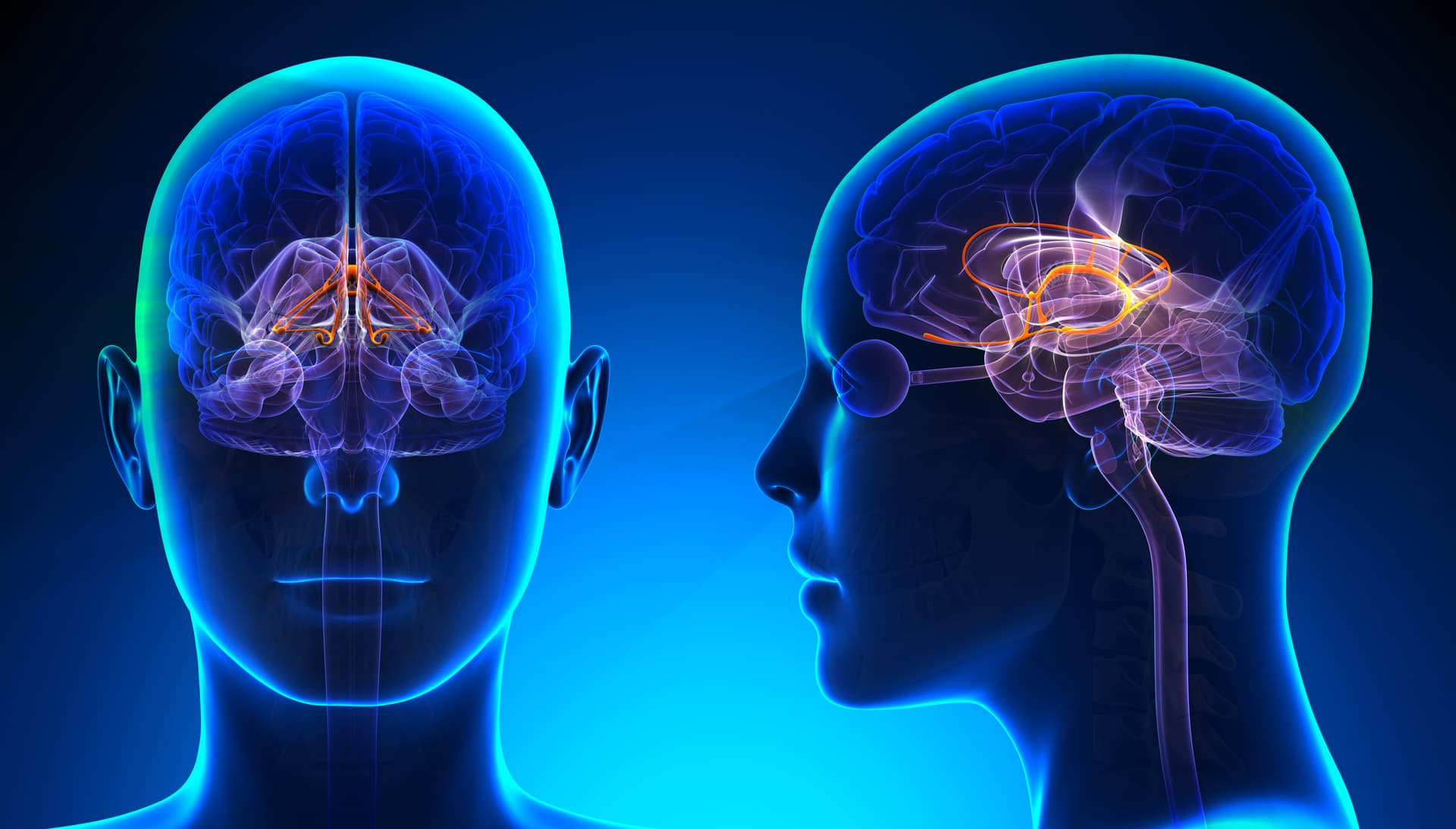
Brain Chemistry
Brain neurotransmitter
Neurons expressing certain types of neurotransmitters sometimes form distinct systems, where activation of the system affects large volumes of the brain, called volume transmission. Major neurotransmitter systems include the noradrenaline(norepinephrine) system, the dopaminesystem, the serotonin system, and the cholinergic system, among others. Trace amines have a modulatory effect on neurotransmission in monoamine pathways (i.e., dopamine, norepinephrine, and serotonin pathways) throughout the brain via signaling through trace amine-associated receptor
A balanced brain supports a homeostatic relationship between excitatory and inhibitory neurotransmitter activity.
Diseases and disorders
Diseases and disorders may also affect specific neurotransmitter systems. For example, problems in producing dopamine can result in Parkinson's disease, a disorder that affects a person's ability to move as they want to, resulting in stiffness, tremors or shaking, and other symptoms. Some studies suggest that having too little or too much dopamine or problems using dopamine in the thinking and feeling regions of the brain may play a role in disorders like schizophrenia or attention deficit hyperactivity disorder(ADHD). Similarly, after some research suggested that drugs that block the recycling, or reuptake, of serotonin seemed to help some people diagnosed with depression, it was theorized that people with depressionmight have lower-than-normal serotonin levels. Though widely popularized, this theory was not borne out in subsequent research. Furthermore, problems with producing or using glutamate have been suggestively and tentatively linked to many mental disorders, including autism, obsessive compulsive disorder (OCD), schizophrenia, and depression.
Causes of neurotransmitter dysfunction
Prolonged periods of stress can deplete neurotransmitters levels. Our fast paced, fast food society greatly contributes to these imbalances.
Poor Diet. Neurotransmitters are made in the body from proteins. Also required are certain vitamins and minerals called "cofactors" If your nutrition is poor and you do not take in enough protein, vitamins, or minerals to build the neurotransmitters, a neurotransmitter imbalance develops. We really do think and feel what we eat.
Genetic factors, faulty metabolism, and digestive issues can impair absorption and breakdown of our food which reduces are ability to build neurotransmitters.
Toxic substances like heavy metals, pesticides, drug use, and some prescription drugs can cause permanent damage to the nerves that make neurotransmitters.
Certain drugs and substances such as caffeine, alcohol, nicotine, NutraSweet, antidepressants, and some cholesterol lowering medications deplete neurotransmitter levels leading to neurotransmitter imbalances.
Hormone changes cause neurotransmitter imbalances
Resources
integrativepsychiatry.net:Imbalance Be Causing Your Mood Problems
thoughtco.com: Neurotransmitters Definition And List
en.m.wikipedia.org: Neurotransmitter
mindlabpro.com: Neurotransmitters
psychology.wikia.com: Neurotransmitters
Thanks for visiting my page.
Leave a comment below if you find the topic helpful. Don't forget to Upvote and Follow @jaybaba. Best Regards @jaybaba
Interesting article,
How often these neurotransmitters are get damaged by any physical or electric shock?
Thanks for reading my article.
A nerve is made up of many neurons, often called a nerve bundle. As individual neurons fade and/or die, the amount of neurotransmitter sent through a nerve bundle decreases.
Copying and pasting contents word for word is not allowed. If you must copy word for word, use the quote(>) function and include the source
Congratulations @jaybaba! You received a personal award!
You can view your badges on your Steem Board and compare to others on the Steem Ranking
Vote for @Steemitboard as a witness to get one more award and increased upvotes!